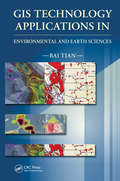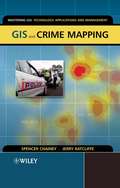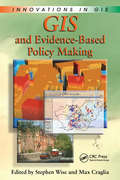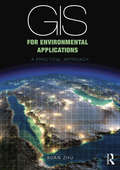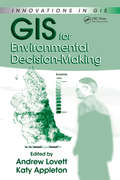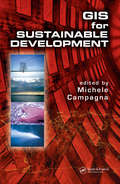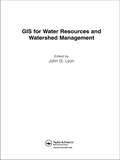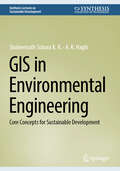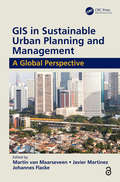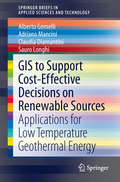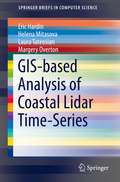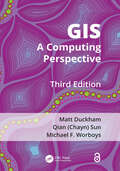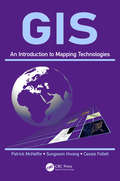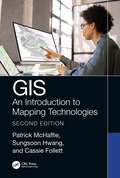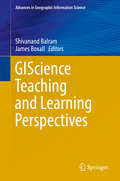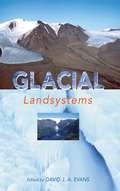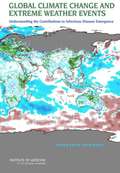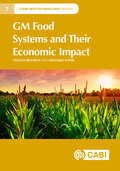- Table View
- List View
GIS Technology Applications in Environmental and Earth Sciences
by Bai TianThis book starts with an overview of GIS technology, what GIS technology is, what it can do, what software products are available, etc. Then, throughout the book, the author explains with many case studies, programs, maps, graphics, and 3D models how GIS and other related technologies can be used to automate mapping processes, collect, process, edit, store, manage, and share datasets, statistically analyze data, model, and visualize large datasets to understand patterns, trends, and relationships to make educated decisions. This book is an excellent resource for anyone who is interested in GIS and related technologies, geology, natural resource, and environmental science.
GIS and Crime Mapping
by Spencer Chainey Jerry RatcliffeThe growing potential of GIS for supporting policing and crime reduction is now being recognised by a broader community. GIS can be employed at different levels to support operational policing, tactical crime mapping, detection, and wider-ranging strategic analyses. With the use of GIS for crime mapping increasing, this book provides a definitive reference.GIS and Crime Mapping provides essential information and reference material to support readers in developing and implementing crime mapping. Relevant case studies help demonstrate the key principles, concepts and applications of crime mapping.This book combines the topics of theoretical principles, GIS, analytical techniques, data processing solutions, information sharing, problem-solving approaches, map design, and organisational structures for using crime mapping for policing and crime reduction. Delivered in an accessible style, topics are covered in a manner that underpins crime mapping use in the three broad areas of operations, tactics and strategy.Provides a complete start-to-finish coverage of crime mapping, including theory, scientific methodologies, analysis techniques and design principles.Includes a comprehensive presentation of crime mapping applications for operational, tactical and strategic purposes.Includes global case studies and examples to demonstrate good practice.Co-authored by Spencer Chainey, a leading researcher and consultant on GIS and crime mapping, and Jerry Ratcliffe, a renowned professor and former police officer.This book is essential reading for crime analysts and other professionals working in intelligence roles in law enforcement or crime reduction, at the local, regional and national government levels. It is also an excellent reference for undergraduate and Masters students taking courses in GIS, Geomatics, Crime Mapping, Crime Science, Criminal Justice and Criminology.
GIS and Evidence-Based Policy Making
by Stephen Wise Max CragliaAlthough much has been written on evidence-based policy making, this is the first volume to address the potential of GIS in this arena. GIS and Evidence-Based Policy Making covers the development of new methodological approaches, emphasizing the identification of spatial patterns in social phenomena. It examines organizational issues, including the
GIS and Geocomputation for Water Resource Science and Engineering (Wiley Works)
by Barnali Dixon Venkatesh UddameriGIS and Geocomputation for Water Resource Science and Engineering not only provides a comprehensive introduction to the fundamentals of geographic information systems but also demonstrates how GIS and mathematical models can be integrated to develop spatial decision support systems to support water resources planning, management and engineering. The book uses a hands-on active learning approach to introduce fundamental concepts and numerous case-studies are provided to reinforce learning and demonstrate practical aspects. The benefits and challenges of using GIS in environmental and water resources fields are clearly tackled in this book, demonstrating how these technologies can be used to harness increasingly available digital data to develop spatially-oriented sustainable solutions. In addition to providing a strong grounding on fundamentals, the book also demonstrates how GIS can be combined with traditional physics-based and statistical models as well as information-theoretic tools like neural networks and fuzzy set theory.
GIS and Machine Learning for Small Area Classifications in Developing Countries
by Adegbola OjoSince the emergence of contemporary area classifications, population geography has witnessed a renaissance in the area of policy related spatial analysis. Area classifications subsume geodemographic systems which often use data mining techniques and machine learning algorithms to simplify large and complex bodies of information about people and the places in which they live, work and undertake other social activities. Outputs developed from the grouping of small geographical areas on the basis of multi- dimensional data have proved beneficial particularly for decision-making in the commercial sectors of a vast number of countries in the northern hemisphere. This book argues that small area classifications offer countries in the Global South a distinct opportunity to address human population policy related challenges in novel ways using area-based initiatives and evidence-based methods. This book exposes researchers, practitioners, and students to small area segmentation techniques for understanding, interpreting, and visualizing the configuration, dynamics, and correlates of development policy challenges at small spatial scales. It presents strategic and operational responses to these challenges in cost effective ways. Using two developing countries as case studies, the book connects new transdisciplinary ways of thinking about social and spatial inequalities from a scientific perspective with GIS and Data Science. This offers all stakeholders a framework for engaging in practical dialogue on development policy within urban and rural settings, based on real-world examples. Features: The first book to address the huge potential of small area segmentation for sustainable development, combining explanations of concepts, a range of techniques, and current applications. Includes case studies focused on core challenges that confront developing countries and provides thorough analytical appraisal of issues that resonate with audiences from the Global South. Combines GIS and machine learning methods for studying interrelated disciplines such as Demography, Urban Science, Sociology, Statistics, Sustainable Development and Public Policy. Uses a multi-method approach and analytical techniques of primary and secondary data. Embraces a balanced, chronological, and well sequenced presentation of information, which is very practical for readers.
GIS and the Social Sciences: Theory and Applications
by Graham Clarke Dimitris Ballas Rachel S. Franklin Andy NewingGIS and the Social Sciences offers a uniquely social science approach on the theory and application of GIS with a range of modern examples. It explores how human geography can engage with a variety of important policy issues through linking together GIS and spatial analysis, and demonstrates the importance of applied GIS and spatial analysis for solving real-world problems in both the public and private sector. The book introduces basic theoretical material from a social science perspective and discusses how data are handled in GIS, what the standard commands within GIS packages are, and what they can offer in terms of spatial analysis. It covers the range of applications for which GIS has been primarily used in the social sciences, offering a global perspective of examples at a range of spatial scales. The book explores the use of GIS in crime, health, education, retail location, urban planning, transport, geodemographics, emergency planning and poverty/income inequalities. It is supplemented with practical activities and datasets that are linked to the content of each chapter and provided on an eResource page. The examples are written using ArcMap to show how the user can access data and put the theory in the textbook to applied use using proprietary GIS software. This book serves as a useful guide to a social science approach to GIS techniques and applications. It provides a range of modern applications of GIS with associated practicals to work through, and demonstrates how researcher and policy makers alike can use GIS to plan services more effectively. It will prove to be of great interest to geographers, as well as the broader social sciences, such as sociology, crime science, health, business and marketing.
GIS for Environmental Applications: A practical approach
by Xuan ZhuGIS for Environmental Applications provides a practical introduction to the principles, methods, techniques and tools in GIS for spatial data management, analysis, modelling and visualisation, and their applications in environmental problem solving and decision making. It covers the fundamental concepts, principles and techniques in spatial data, spatial data management, spatial analysis and modelling, spatial visualisation, spatial interpolation, spatial statistics, and remote sensing data analysis, as well as demonstrates the typical environmental applications of GIS, including terrain analysis, hydrological modelling, land use analysis and modelling, ecological modelling, and ecosystem service valuation. Case studies are used in the text to contextualise these subjects in the real world, examples and detailed tutorials are provided in each chapter to show how the GIS techniques and tools introduced in the chapter can be implemented using ESRI ArcGIS (a popular GIS software system for environmental applications) and other third party extensions to ArcGIS to address. The emphasis is placed on how to apply or implement the concepts and techniques of GIS through illustrative examples with step-by-step instructions and numerous annotated screen shots. The features include: Over 350 figures and tables illustrating how to apply or implement the concepts and techniques of GIS Learning objectives along with the end-of-chapter review questions Authoritative references at the end of each chapter GIS data files for all examples as well as PowerPoint presentations for each chapter downloadable from the companion website. GIS for Environmental Applications weaves theory and practice together, assimilates the most current GIS knowledge and tools relevant to environmental research, management and planning, and provides step-by-step tutorials with practical applications. This volume will be an indispensable resource for any students taking a module on GIS for the environment.
GIS for Environmental Decision-Making (Innovations in GIS)
by Andrew Lovett Katy AppletonEnvironmental applications have long been a core use of GIS. However, the effectiveness of GIS-based methods depends on the decision-making frameworks and contexts within which they are employed. GIS for Environmental Decision-Making takes an interdisciplinary look at the capacities of GIS to integrate, analyze, and display data on which decisions
GIS for Sustainable Development
by Michele CampagnaGIS for Sustainable Development examines how GIS applications can improve collaboration in decision making among those involved in promoting sustainable development. This volume reviews leading GIScience, providing an overview of research topics and applications that enable GIS newcomers and professionals to apply GIScience methods to susta
GIS for Water Resource and Watershed Management
by John G. LyonThe use of GIS, and its application for solving environmental problems is growing rapidly. This powerful set of tools can be used to great effect in hydrological modeling, environment and habitat assessments, ecosystem studies, monitoring of wetlands and forested watersheds, urban studies, agricultural impact assessment and much more. GIS for Water
GIS in Environmental Engineering: Core Concepts for Sustainable Development (Synthesis Lectures on Sustainable Development)
by A. K. Haghi Shaheemath Suhara K. K.The book covers applications of Geographic Information System (GIS) and remote sensing in the fields of hydrology, water resource management, land use, rainfall variability, and groundwater mapping, to help professionals in the field identify change in patterns and guide them in making decisions that promote sustainable development.
GIS in Land and Property Management
by Peter Wyatt Martin P. RalphsEconomists, geographers and surveyors are beginning to recognise the powerful tool which a Geographical Information System (GIS) offers in effective property management. It provides a means of managing land and property information digitally and in a geographical context, and allows for rapid access to information and a means of analyzing that information in a geographical context.GIS in Land and Property Management shows how to use GIS, both in principle and in practice. It introduces digital mapping and GIS, along with a brief history of the development of GIS and LIS, all with an emphasis on property. In presenting the spectrum of GIS applications in property management it gives a number of case studies from a variety of market sectors, and it analyzes the issues to provide guidance and a number of recommendations for the implementation of GIS. At the same time common themes and issues are drawn out to present a coherent message for students and practitioners.The book is useful for undergraduate and postgraduate students on land management, built environment, economics and geography courses, and for property professionals, in both public and private sectors, looking to GIS as a property management decision aid.
GIS in Sustainable Urban Planning and Management (Open Access): A Global Perspective
by Martin Van Maarseveen Javier Martinez Johannes FlackeThe Open Access version of this book, available at http://www.tandfebooks.com/doi/view/10.1201/9781315146638, has been made available under a Creative Commons Attribution-Non Commercial-No Derivatives 3.0 license. <P><P> GIS is used today to better understand and solve urban problems. GIS in Sustainable Urban Planning and Management: A Global Perspective, explores and illustrates the capacity that geo-information and GIS have to inform practitioners and other participants in the processes of the planning and management of urban regions. The first part of the book addresses the concept of sustainable urban development, its different frameworks, the many ways of measuring sustainability, and its value in the urban policy arena. The second part discusses how urban planning can shape our cities, examines various spatial configurations of cities, the spread of activities, and the demands placed on different functions to achieve strategic objective. It further focuses on the recognition that urban dwellers are increasingly under threat from natural hazards and climate change. <P><P> Written by authors with expertise on the applications of geo-information in urban management, this book showcases the importance of GIS in better understanding current urban challenges and provides new insights on how to apply GIS in urban planning. It illustrates through real world cases the use of GIS in analyzing and evaluating the position of disadvantaged groups and areas in cities and provides clear examples of applied GIS in urban sustainability and urban resilience. <P><P> The idea of sustainable development is still very much central in the new development agenda of the United Nations, and in that sense, it is of particular importance for students from both the Global South and Global North. Professionals, researchers, and students alike will find this book to be an invaluable resource for understanding and solving problems relating to sustainable urban planning and management.
GIS to Support Cost-effective Decisions on Renewable Sources
by Claudia Diamantini Sauro Longhi Adriano Mancini Alberto GemelliThrough the results of a developed case study of information system for low temperature geothermal energy, GIS to Support Cost-effective Decisions on Renewable Sources addresses the issue of the use of Geographic Information Systems (GIS) in evaluating cost-effectiveness of renewable resource exploitation on a regional scale. Focusing on the design of a Decision Support System, a process is presented aimed to transform geographic data into knowledge useful for analysis and decision-making on the economic exploitation of geothermal energy. This detailed description includes a literature review and technical issues related to data collection, data mining, decision analysis for the informative system developed for the case study. A multi-disciplinary approach to GIS design is presented which is also an innovative example of fusion of georeferenced data acquired from multiple sources including remote sensing, networks of sensors and socio-economic censuses. GIS to Support Cost-effective Decisions on Renewable Sources is a useful, practical reference for engineers, managers and researchers involved in the design of GIS, decision support systems, investment planning/strategy in renewable energy and ICT innovation in this field.
GIS, Applied Computing and Data Science for Water Management: Selected Papers of the 4th International Conference GIRE3D Participatory and Integrated Management of Water Resources in Arid Zones (Lecture Notes in Geoinformation and Cartography)
by Noamen Rebai Aniss Moumen Mohamed El BouhaddiouiThis book contains a selection of the best articles presented at the 4th International Conference GIRE3D - Participatory and Integrated Management of Water Resources in Arid Zones, November 23th-25th , Help at Laayoune - Morocco, co-organized by Moroccan Committee of the International Hydraulics Association (CM-AIH) and Hydraulic basin agency of Sakia El Hamra and Oued Eddahab (ABHSHOD). It discusses the role of computational and geospatial technologies for water resources sustainable management and is intended primarily for professional, researchers, teachers and postgraduate students in fields that can benefit from geoinformation—both within and outside the areas of geographic information science, modelling and optimization.
GIS-based Analysis of Coastal Lidar Time-Series
by Eric Hardin Helena Mitasova Laura Tateosian Margery OvertonThis SpringerBrief presents the principles, methods, and workflows for processing and analyzing coastal LiDAR data time-series. Robust methods for computing high resolution digital elevation models (DEMs) are introduced as well as raster-based metrics for assessment of topographic change. An innovative approach to feature extraction and measurement of feature migration is followed by methods for estimating volume change and sand redistribution mapping. Simple methods for potential storm impacts and inundation pattern analysis are also covered, along with visualization techniques to support analysis of coastal terrain feature and surface dynamics. Hands-on examples in GRASS GIS and python scripts are provided for each type of analysis and visualization using public LiDAR data time-series. GIS-based Analysis of Coastal Lidar Time-Series is ideal for professors and researchers in GIS and earth sciences. Advanced-level students interested in computer applications and engineering will also find this brief a valuable resource.
GIS: A Computing Perspective
by Matt Duckham Michael F. Worboys Qian (Chayn) SunFollowing two successful editions, the third edition of GIS: A Computing Perspective has been completely revised and updated, with extensive new content reflecting the significant progress that has been made in the realm of GIS within the last 20 years. Major new topics covered for the first time in this edition include: graph databases and graph query languages, ontology engineering and qualitative spatial reasoning, geosensor networks and GeoAI, decentralized computing and online algorithms, and critical GIS and data sovereignty. Features Includes an entirely new chapter on AI and GIS, including ontologies and the Semantic Web, knowledge representation (KR) and spatial reasoning, machine learning and spatial analysis, and neural networks and deep learning Presents new material reflecting the advances made in cloud computing, stream computing, and sensor networks, as well as extensively revised and updated content on cartography, visualization, and interaction design Connects the technology to the social aspects and implications of GIS, including privacy and fair information practices, FATE (fairness, accountability, transparency, and ethics), and codes of conduct for responsible use of GIS Integrates the necessary background to foundational areas, such as databases and data structures, algorithms and indexes, and system architecture and AI, provided in context so readers new to those topics can still understand the concepts being discussed Incorporates over 20 carefully explained spatial algorithms; over 60 inset boxes with in-depth material that enriches the central topics; and more than 300 color figures to support the reader in mastering key concepts Welcomes a new coauthor, Qian (Chayn) Sun, to the third edition, who brings her expertise in topics such as web mapping, cloud computing, critical geography, and machine learning with big spatial data Intended for anyone interested in understanding GIS, especially students taking upper-level undergraduate and graduate courses in computer science and geography, as well as academics, researchers, practitioners, and professionals working in the field and involved in advanced GIS projects.
GIS: An Introduction to Mapping Technologies
by Patrick McHaffie Sungsoon Hwang Cassie FollettThe purpose of this textbook is to provide an accessible introduction to geotechnology for a wide range of students. The techniques and approaches to problem solving, project organization and management, and data visualization are used with the intension of introducing students to the possibility of using GIS as a platform for making contributions to a wide range of programs that are concerned with social, economic, political, and environmental change. Includes activities that lead students through hands-on workflows to create flexible and functional "solutions" to specific tasks that are typical for geospatial analysts.
GIS: An Introduction to Mapping Technologies, Second Edition
by Patrick McHaffie Sungsoon Hwang Cassie FollettThe second edition of this introductory GIS textbook is thoroughly rewritten and updated to respond to the demand for critical engagement with technologies that address relevant issues across several disciplines preparing students for higher-level work in geotechnologies. Chapters are arranged to (1) build competence in fundamental skills, (2) explore applications of higher-level managerial and analytical functions that are typically called upon in public, nonprofit, and private sector milieu, and (3) propose and detail a template for organizing, executing, and completing a GIS project successfully. This interests all users from beginners to experienced professionals. Features: Uses the latest version of ArcGIS Pro (3.0) to present a fully rewritten and updated text with diverse perspectives. Includes many real-world examples with urban planning, environmental, and social justice foci. Presents new discussions, examples, and lab materials on open-source GIS projects. Junior and senior level undergraduate students taking courses in remote sensing and GIS applications, studying in the fields of Geography, Environmental Sciences, Computer Science, Urban Studies, Public Health, and Social Disciplines, as well as researchers and academics in the same fields, will all benefit from the information provided in the updated version of this book.
GIScience Teaching and Learning Perspectives (Advances in Geographic Information Science)
by Shivanand Balram James BoxallThis volume uniquely links educational theories and the practice of GIScience in higher education contexts to guide classroom practice, present effective practical implementations from peers, and provide resources and strategies for effective teaching methods. The book offers a comprehensive exploration of GIScience education, including current trends and future educational needs in GIScience, and will act as a resource to prepare learners for a world that demands more intensive investment in present-day education and technological literacy. Additionally, the indirect benefit of merging the fragmented literature on GIScience literacy will provide a basis to examine common techniques and enable a new wave of research more rooted in learning theories. In ten chapters, the book is designed to attract an audience from geographic information systems science, geomatics, spatial information science, cartography, information technology, and educational technology as focus disciplines.
GLACIAL LANDSYSTEMS (A\hodder Arnold Publication)
by David Evans Liz GoosterThis book is a comprehensive overview of the ever-captivating field of glaciation from the perspective of glacial landsystems. This approach models the many processes, forms and interactions that can be found in glaciated landscapes throughout the world. Landsystems models allow the glacial geologist and geomorphologist to evaluate these landscapes in relation to the dynamics of glaciation and to climate and geology. Glacial Landsystems brings together the expertise of an international range of specialists to provide an up-to-date summary of landsystems relevant to both modern and ancient glacier systems and also in the reconstruction and interpretation of former glacial environments. The models are applicable at all scales from ice sheets to small valley glaciers.This book is an essential reference for anyone embarking upon research or engineering surveys in glaciated basins and provides a wide-ranging handbook of glacial landsystem types for students of glaciation.
GLOBAL AIR QUALITY: An Imperative for Long-Term Observational Strategies
by Committee on Atmospheric ChemistryA report on Global Air Quality
GLOBAL CLIMATE CHANGE AND EXTREME WEATHER EVENTS: Understanding the Contributions to Infectious Disease Emergence
by Institute of Medicine of the National AcademiesLong before the "germ theory" of disease was described, late in the nineteenth century, humans knew that climatic conditions influence the appearance and spread of epidemic diseases. Ancient notions about the effects of weather and climate on disease remain embedded in our collective consciousness-through expressions such as "cold" for rhinovirus infections; "malaria," derived from the Latin for "bad air;" and the common complaint of feeling "under the weather." Today, evidence is mounting that earth's climate is changing at a faster rate than previously appreciated, leading researchers to view the longstanding relationships between climate and disease with new urgency and from a global perspective. On December 4 and 5, 2007, the Forum on Microbial Threats hosted a public workshop in Washington, DC to consider the possible infectious disease impacts of global climate change and extreme weather events on human, animal, and plant health, as well as their expected implications for global and national security.
GM Food Systems and Their Economic Impact (CABI Biotechnology Series)
by Dr Tatjana Brankov Dr Koviljko LovreThe development of transgenic crops is revolutionary, but what does it mean for food production, prices and the environment? This is the first book to examine the economic evidence in a methodical way. It initially describes the historical evolution of biotechnology and defines key terms, before moving on to explore transgenic technology and food regime concepts. The book analyzes genetically modified organism (GMO) policy as part of overall agrarian policy, considering neoregulation in the USA, the EU, Brazil, Russia, China, India, South Africa and Serbia; as well as discussing agricultural performance, support and trade relations. The effect of transgenic food production on world food prices is also examined, along with food security at global and regional levels, and the links between GMOs and world hunger. The environmental implications of transgenic technology are considered through analysis of pesticide and fertilizer usage and efficiency, and pesticide consumption in GMO and non-GMO producing countries. Finally, the book considers the entry of transgenic ingredients into the food chain and lists the products affected. Key features: - Detailed analysis of economic data. - Comparison of international trends, including BRICS countries (Brazil, Russia, India, China and South Africa) and Serbia. - Evaluation of environmental and food security implications. - Glossary of important terms. This book will be valuable for agricultural economists, including students at Masters and PhD level. It will also be of interest to agricultural engineers, food technologists, nutritionists, industry representatives, policy makers, policy advisers and analysts and NGOs.
GM Food Systems and Their Economic Impact (CABI Biotechnology Series)
by Dr Tatjana Brankov Dr Koviljko LovreThe development of transgenic crops is revolutionary, but what does it mean for food production, prices and the environment? This is the first book to examine the economic evidence in a methodical way. It initially describes the historical evolution of biotechnology and defines key terms, before moving on to explore transgenic technology and food regime concepts. The book analyzes genetically modified organism (GMO) policy as part of overall agrarian policy, considering neoregulation in the USA, the EU, Brazil, Russia, China, India, South Africa and Serbia; as well as discussing agricultural performance, support and trade relations. The effect of transgenic food production on world food prices is also examined, along with food security at global and regional levels, and the links between GMOs and world hunger. The environmental implications of transgenic technology are considered through analysis of pesticide and fertilizer usage and efficiency, and pesticide consumption in GMO and non-GMO producing countries. Finally, the book considers the entry of transgenic ingredients into the food chain and lists the products affected. Key features: - Detailed analysis of economic data. - Comparison of international trends, including BRICS countries (Brazil, Russia, India, China and South Africa) and Serbia. - Evaluation of environmental and food security implications. - Glossary of important terms. This book will be valuable for agricultural economists, including students at Masters and PhD level. It will also be of interest to agricultural engineers, food technologists, nutritionists, industry representatives, policy makers, policy advisers and analysts and NGOs.
